[ad_1]
We have entered 2023 talking about GA4 and we’ll do the same in 2024. Regular readers of Search Engine Land — and all SEOs, for that matter — know why: GA4 wasn’t ready for prime time when Google forced us to make the switch, and we’re still buckling through it months later to.
That said, I’ve managed to hone some extremely valuable GA4 reports that I use to help my clients chart their course toward organic growth in 2024. Let’s take a look at:
- What they are.
- How to set them up.
- What they show you.
- How to use the insights.
Report 1: Landing Page Performance
This report looks at landing page performance segmented by channel. Choose the most relevant date range you want to study. For example, I usually use this as a monthly or quarterly overview.
Mechanics
First go to Engagement > Landing page:
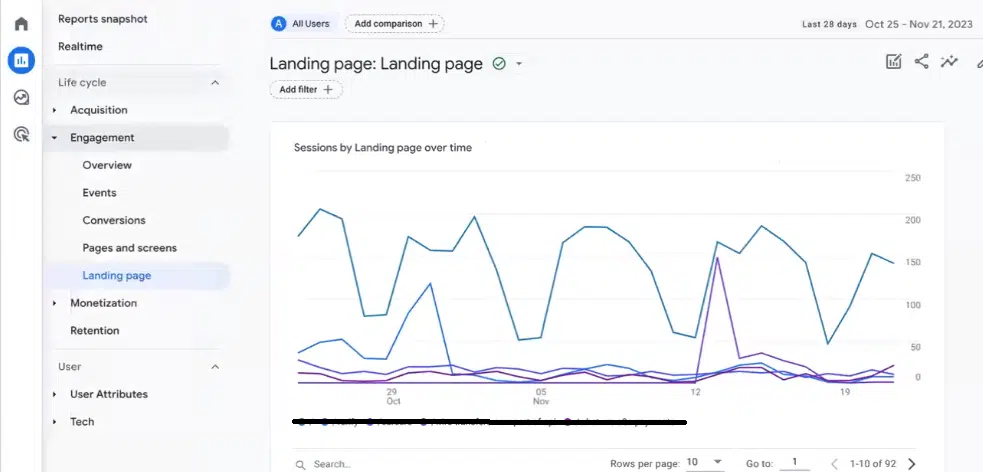

Next, make sure you have a Conversion column and specify the primary conversion you want to analyze (here we examine form submissions):
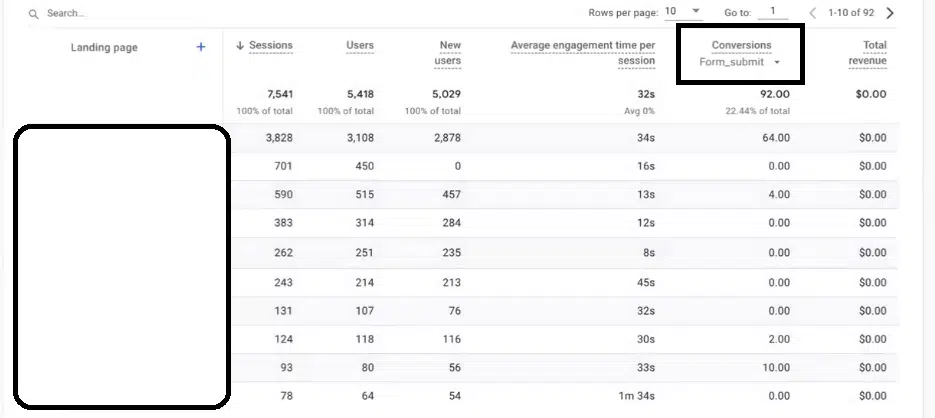

For an extra layer of insights, add a Source/medium dimension of the report:
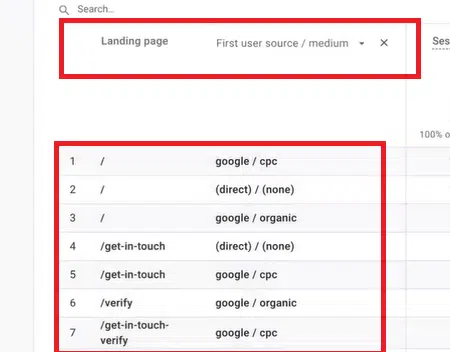

What does it show you?
This gives marketers a good overview of some possibilities.
First, if you sort by descending sessions, you can see the most viewed landing pages and quickly assess which ones are lagging in terms of conversion rate.
This should prompt an inspection of the page – whether this is the case optimized for conversionregardless of the traffic source.
You can then sort by the lowest sessions and look for low-volume pages with recorded conversions. These may be more niche, but they can help you identify conversion-friendly features and/or themes that you can double down on with additional ad spend.
Broken down by landing page and channel performance, you can see which channels may be in dire need of ad-to-landing page optimization, among other insights.
How do you bake the insights into your strategy?
First, high-volume landing pages, which attract a lot of ad spend (and/or organic attention) and few conversions, should be high on your list of features to optimize in 2024.
You may also want to have your product team review the list to assess whether there are any market anomalies or competitive disadvantages that page performance indicates.
Second, the lower volume pages that succeed in converting users should contain some insights about what’s working, which you should try to replicate – or supplement with additional resources.
Get the daily newsletter marketers trust.
Report 2: Content Gap Analysis
You don’t need much GA4 manipulation for this. What you do need is an idea of the segments you want to monitor for content.
These could be stages of the buying journey (top, middle, bottom), primary products/services, or types of audiences/personas.
Mechanics
You can use the landing page report above to determine the list size you want to study. Download the top 20, 50, or 100 (for example) landing pages and start categorizing them all based on the segments you’re focusing on.
What does it show you?
When you’re done, you’ll clearly see which segments need attention in 2024.
A common use case (and outcome) is content gap analysis across stages of the buying journey, with blogs filling the top of the funnel, resources and About pages filling the middle, and pages like Contact Us, Pricing, and Comparisons. charts focus on the bottom of the funnel.
This report allows you to track how many of each page type you create and assess the mix of content each stage represents. You might find something like this: Of the 100 pieces of content on your website, 90 are thought leadership blog posts, and 10 of them are contact and bottom funnel pages, but the middle of the funnel is underrepresented.
I often find that brands have overloaded their content in the middle of the funnel, telling everything about themselves and their products. This comes at the expense of top-of-funnel content that increases brand and product awareness and takes users along the journey to begin with.
How do you bake the insights into your strategy?
Make sure you align with overall business goals before taking action on the findings of your content gap analysis. For example, if your company’s top priority is increasing awareness for a particular product, the analysis you just performed that shows a lack of content for other products is something you should tuck away but not take action on. to undertake.
Ideally, the analysis should show a clear opportunity to contribute to your company’s primary objectives. If there is an audience (let’s say CFOs) in focus and there is some content but room for more, you can drill down to:
- Research CFO-specific topics you’ve already covered and try to optimize those pages.
- Create CFO-related content to cover what you haven’t covered yet.
Report 3: Funnel exploration
This report allows you to select one of the most important pages (or several) and analyze how users behave once they get there. One of my favorite use cases is to see how many people actually convert through blog posts, which I’ll show in the example below.
Mechanics
First go to Reconnaissance > Funnel reconnaissance:


Edit your funnel steps:
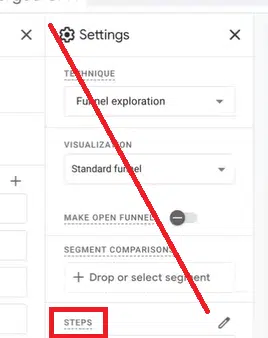

Then set your flow. Below I have specified that the first page visited must contain the following /sources (this is the client’s blog URL) and I added a conversion event (gated lead form) as an additional step to be completed at some point during the user’s visit:
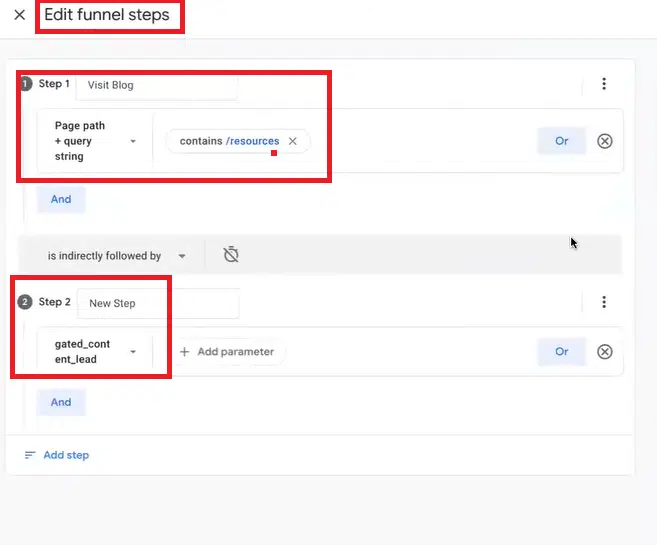

add a Dimension or Breaking down by first user medium if you want to see the channel that brought the user to your page. In this example, I was able to provide the client with some pretty eye-opening data:
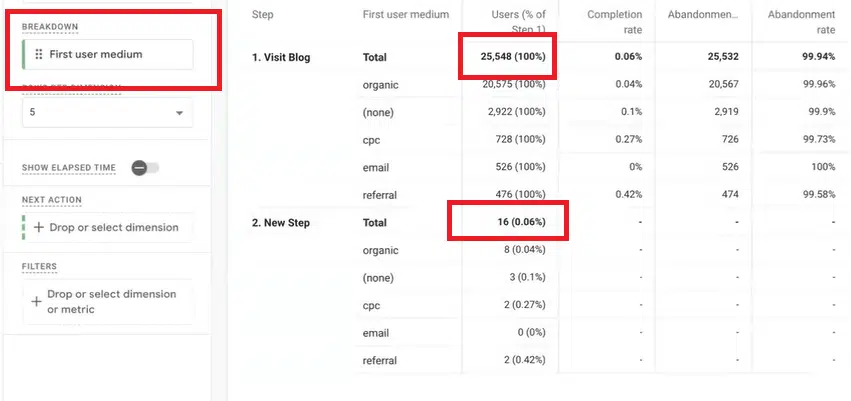

What does it show you?
This example showed that while the client was successful in driving people to their site through blog content (usually from organic sources), the blog rarely converted.
This is a call to action to change your conversion strategies. For example, examine the CTA to see if it matches the type of content the user is consuming.
How do you bake the insights into your strategy?
The example above shows you how to identify large portions of your earned properties that are ripe for conversion optimization, but you can use the funnel exploration report in several ways.
One thing I like to show clients is to start with the homepage, ask them to define the journey they want users to take, and run the report to see how many people actually follow through.
If the number is lower than expected, outline some UX testing to understand why – and determine how you can be more proactive in sending users where you want them.
Chart your SEO course for 2024 with these 3 valuable GA4 reports
Ultimately, I still think GA4 will be a useful platform that will be a necessary touchpoint for marketing teams – especially if the platform can include insights about SGE as Google expands that footprint.
While we all (hopefully) try to stick to our 2024 resolutions, try rolling up your sleeves and making the most of what GA4 has to offer. If Google meets us halfway and makes the platform more intuitive and consistent, fluency with the levers will ultimately be worth the time and effort.
The opinions expressed in this article are those of the guest author and not necessarily those of Search Engine Land. Staff authors are credited here.
[ad_2]



